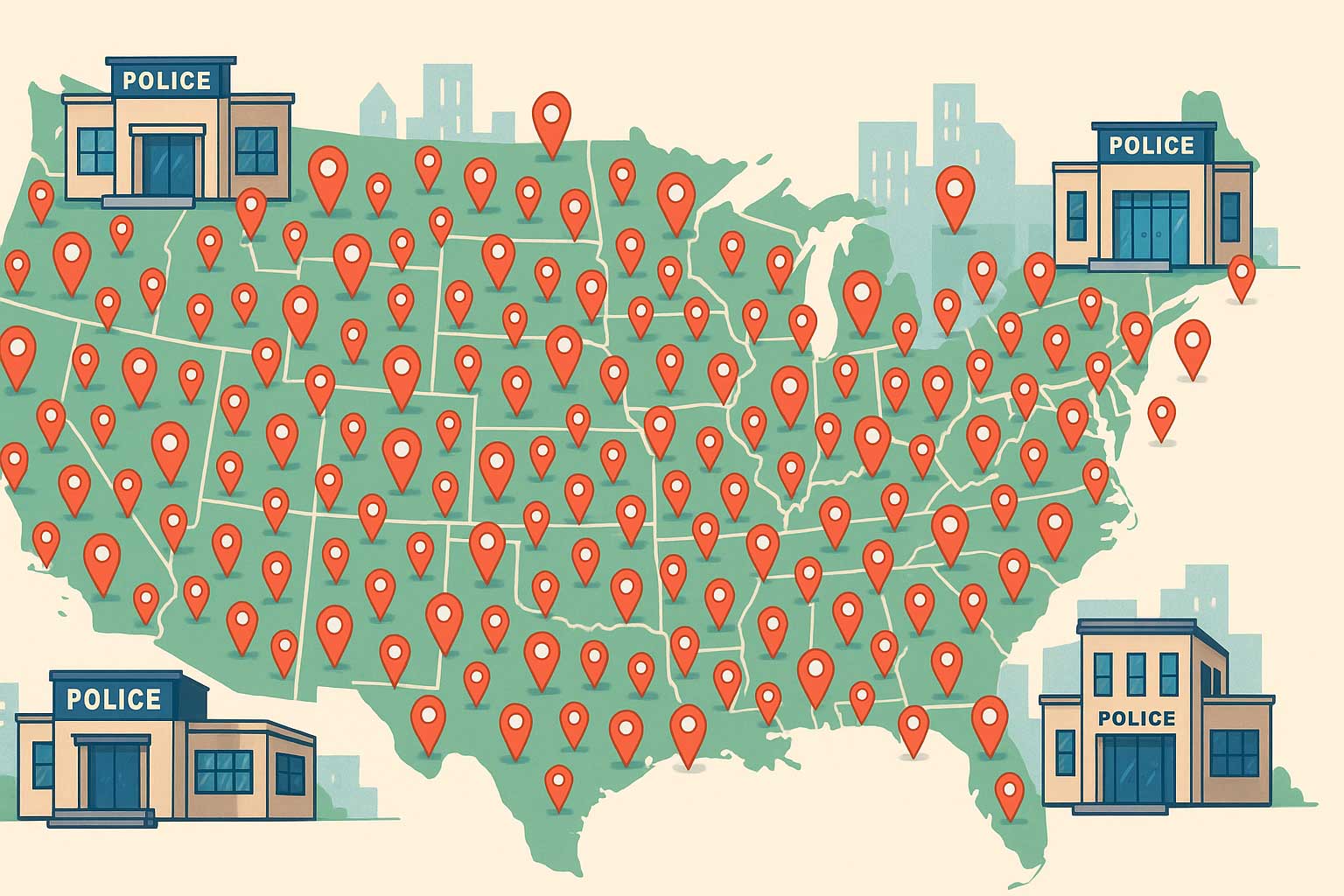If you listen to the pulse of local law enforcement in 2025, the beat is steady—but faint in places. The landscape is shifting beneath the boots of American officers, shaped by years of attrition, evolving public expectations, and changing workplace dynamics.
Yet the story is not one of collapse—it’s one of slow recalibration. According to fresh data from the Police Executive Research Forum (PERF), the International Association of Chiefs of Police (IACP), and a host of state and municipal sources, local law enforcement employment is no longer in free fall. But it’s still far from where it stood five years ago.
For the uniform manufacturing and distribution community, understanding where local law enforcement employment stands today—and where it’s heading—is essential. Uniform demand isn’t just about total headcount; it’s about hiring cycles, role diversity, funding programs, and policy shifts that reshape what officers wear, who’s wearing it, and how often it gets replaced.
Let’s unpack the 2025 picture.
The Numbers Are Stabilizing—But Not Snapping Back
First, the good news. As of January 2025, local law enforcement agencies nationwide saw a net increase of 0.4% in sworn officers compared to the previous year, according to PERF’s July 2025 staffing survey. Hiring has begun to outpace attrition, at least marginally. In fact, hiring in 2024 surpassed 2019 levels by over 12%, signaling that departments are getting more aggressive—and perhaps more creative—in rebuilding their ranks.
But don’t start celebrating a full recovery just yet. Overall staffing remains 5.2% lower than it was in January 2020. Agencies are still operating, on average, at 91% of their authorized strength. In practical terms, that’s thousands of empty uniforms hanging in lockers—or never ordered in the first place.
The IACP’s 2024 National Recruitment and Retention Survey echoes the reality: 78% of agencies say staffing is worse than five years ago. Only 3% say things have improved. Seventy percent say recruiting is harder than ever.
This national shortfall hits smaller departments especially hard. Many can’t compete on salary or incentives. Some have struggled to fill a single position for years. And in many towns, the next generation of potential officers is simply not knocking.
Retirement Is Still the Elephant in the Squad Room
It’s not just that new hires are scarce—it’s that old hands are leaving in droves. Across many local agencies, 18% to 25% of personnel are eligible for retirement between 2024 and 2028. The BLS projects around 63,000 law enforcement openings each year this decade—mostly due to retirement and attrition.
Departments face the double hit of losing experience and struggling to train replacements fast enough. The generational torch is being passed—sometimes too quickly. The result is a widening leadership gap, rising training costs, and a steep learning curve for younger officers stepping into supervisory roles.
And here’s where it gets practical for our industry: every retirement leads to one last Class A uniform. Every new recruit demands a full uniform kit. And every department experiencing turnover must reorder replacement gear—sometimes for dozens of roles all at once.
Regionalization and Shared Services: Fewer Orders, Bigger Orders
As smaller departments struggle to maintain staffing, regional partnerships are gaining traction. Agencies across counties or adjacent municipalities are consolidating dispatch, jail operations, SWAT units, and even basic patrol functions.
The benefit for law enforcement is pooled resources and streamlined training. For uniform vendors, it means fewer agencies placing orders—but larger, more coordinated orders when they do. Regional RFPs may become the norm, especially for rural or midsize jurisdictions.
This trend changes how uniforms are specified and stocked. Shared uniforms need to be consistent across jurisdictions while accommodating a broader range of roles—from courthouse bailiffs to bike patrol to school officers.
Vendors with scalable solutions, consistent color dye lots, and experience handling contract rollouts across multiple agencies will be well-positioned to serve this evolving procurement model.
Hiring Is Getting Creative—and So Are Uniforms
Agencies that are growing again aren’t doing it the old-fashioned way. Cities like Laredo, Texas, for instance, have surged in applications by simplifying the hiring process, investing in digital recruiting campaigns, and highlighting their department’s commitment to community policing.
More departments are re-engaging retirees in limited roles—cold case investigations, community outreach, or academy instruction. Albany, NY, is actively recruiting retired officers for part-time posts, saving on training while gaining institutional knowledge.
And then there are roles that didn’t exist a decade ago: crisis co-responders, mental health liaisons, public safety aides. These positions often wear soft uniforms—polo shirts, jackets, or vests that signal “authority,” but also “approachability.”
Each of these hires requires a uniform solution. Maybe not a full tactical kit, but a well-branded, standardized set of apparel that reflects the agency’s mission and image. Suppliers who offer modular packages—where departments can mix and match polos, duty wear, outerwear, and accessories—are increasingly in demand.
The Diversity Drive Is Accelerating
As of 2025, more than 400 agencies have signed the 30×30 Initiative pledge, which aims for 30% of new recruits to be women by 2030. IACP’s latest survey shows that 88% of departments are working on strategies to improve gender and racial diversity.
That goal isn’t just a moral imperative—it’s a logistical one. Uniform sizing, fit, and functionality must expand accordingly. Female-cut duty pants, body armor with curved panels, hijab-compatible headgear, and tailored maternity uniforms are no longer optional. They are procurement requirements.
Uniform companies that fail to serve this expanding demographic will find themselves sidelined on bids. Those that design for inclusivity—and can ship to spec quickly—will be increasingly favored.
Retention and Wellness Mean Comfort Counts
Let’s talk about morale for a minute. Officers are staying in departments where they feel supported—physically and psychologically. That means more agencies are investing in ergonomic gear and uniform upgrades designed with comfort and health in mind.
PERF’s research highlights back injuries from traditional duty belts as a leading physical strain. As a result, external vest carriers, MOLLE load-bearing systems, and breathable performance fabrics are in growing demand.
Many departments now offer alternative duty wear in warm months: stretch-blend cargo pants, moisture-wicking polo shirts, and lightweight duty boots. For training and PT, departments are ordering branded athletic apparel—an expanding submarket for uniform vendors.
The mental side matters, too. Some departments are adjusting their uniform policies to allow lighter colors, softer silhouettes, and optional headgear for community assignments—all in the name of better interaction and officer morale.
Don’t Forget the Grant Trail
One of the best predictors of a uniform purchase is a grant award. Programs like the DOJ’s Bulletproof Vest Partnership, COPS Hiring Program, and Body-Worn Camera Initiative continue to fund large-scale procurement. In many cases, uniform upgrades are required to support these initiatives (new vest carriers, reinforced camera mounts, reflective accessories).
The National Conference of State Legislatures reports that more than 1,600 police-related bills were introduced in 2024 alone—many of which included funds for officer safety, recruitment incentives, or uniform modernization. Several states have passed laws incentivizing part-time officers, cross-state certification, and community responder units—all of which require unique apparel.
Smart suppliers track these developments and align their marketing with the timing of grant announcements and RFPs.
Where Do We Go From Here?
Local law enforcement employment isn’t bouncing back overnight. But it is finding a new shape—one more attuned to diversity, health, community connection, and flexibility. It’s not just about putting more officers in seats. It’s about reimagining who those officers are, what they do, and what they wear to do it.
Uniform companies that can think holistically—offering apparel not just as gear, but as a tool for recruitment, retention, performance, and morale—are well-positioned for this moment.
This is no longer a market built solely on navy pants and polyester shirts. It’s a market built on insight, inclusivity, and adaptability. And as departments find their footing, so too must the suppliers who serve them.
Want to Explore More? Here Are Key Reports and Articles Used in This Column:




















